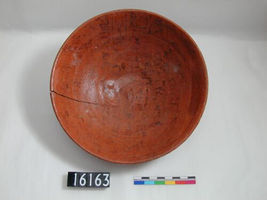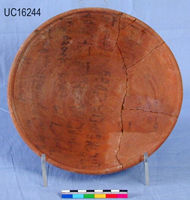| Homepage | Timeline | Maps | A-Z index | Learning |
Letters to the Dead
From the late Old Kingdom (about 2686-2181 BC) to the late New Kingdom (about 1550-1069 BC) there survive about fifteen letters written to relatives who had recently died. Although there are so few sources for the practice, they range widely enough in time and in geographical spread, to suggest that they reflect a broader custom of communication. They provide the most compelling evidence for the strength of belief in a life after death: other practices, such as mummification and rituals for the deceased, might be considered social practice (compare modern church rituals as social norm even for many non-believers), but the letters at least appear more directly personal.
Most of the surviving Letters to the Dead date to the late Old Kingdom (about 2686-2181 BC) and First Intermediate Period, and were found in or at the tomb. They are generally written on bowls, with some examples on linen or papyrus. These letters never have just the simple purpose of keeping in touch with the dead. Instead, they have a practical and urgent motive, and request help for insoluble problems of the living. The dead was treated as still very powerful. A negative spirit of a dead man or woman could be responsible for whatever might be going wrong in life. In the Letters to the Dead the writer insists that she or he has treated the dead person well in life and, by maintaining the cult of the dead, after death, and that there can be no reason for allowing ill fortune to strike the writer. The letters all refer to recently deceased members of the family - husbands, wives, parents - and not to ancestor figures. The misfortunes that cause the letters to be written range from ill health to disputes over property. The dead person is expected to intervene in the afterlife, sometimes at the court of the underworld, to put an end to the problem.
From their immediate family environment, and apparently with no person between living writer and dead reader, the letters are among the most personal expressions in Ancient Egyptian writings. They include the first recorded messages of women from Egypt. The examples from the provinces are among the earliest examples of writing in those regions.
In 1928 Gardiner and Sethe published eight Letters to the Dead: from the late Old Kingdom (about 2686-2181 BC) and First Intermediate Period one example on linen, four on pottery bowls, from the late Second Intermediate Period, two pottery bowls; and from the late New Kingdom (about 1550-1069 BC) one papyrus. Other examples of the First Intermediate Period on papyrus were excavated by George Reisner at Naga el-Deir, and have been published by W K Simpson.
For all these and additional examples, see Wente 1990: 210-219.
The Petrie Museum of Egyptian Archaeology at University College London preserves two of the late Old Kingdom or First Intermediate Period bowls in the publication by Gardiner and Sethe: a letter from Qau, from a man to his parents (father on the inside, mother on the outside) and a letter from Hu, from a woman to her husband.
(click on the images to see a translation and further information)
|
from Qau tomb 7695
|
from Hu
|
 |
 |